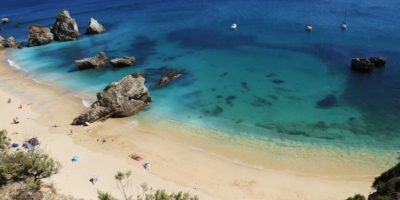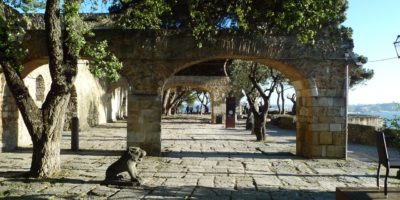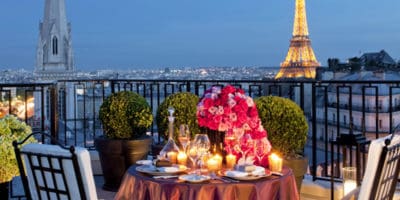
Plitvice Lakes National Park by Pablo BM – Wikimedia Commons
Top 10 Remarkable Facts about Plitvice Lakes National Park
Plitvice Lakes National Park is one of Croatia’s largest and oldest national parks. The national park was founded in 1949. It is located in the mountainous karst area of central Croatia, at the border with Bosnia and Herzegovina.
The protected area covers 296.85 square kilometers (73,350 acres). Approximately 90% of this region is in Lika-Senj County, and the remaining 10% is in Karlovac County. The National Park of the Plitvice Lakes was added to the UNESCO World Heritage List in 1979.
This was because of the region’s exceptional and beautiful network of tufa lakes, caverns, and waterfalls. More than a million visitors arrive annually. Entrance fees can range from zero to 300 kuna, or about €39 per adult per day, in the summer of 2022.
Now let’s look at some remarkable facts about Plitvice Lakes National Park.
1. Got Its Name Due to Natural Phenomena That Created the Lakes
The name Plitvice was first mentioned in a written document in 1777 by Dominik Vukasović, the priest of Otočac. This name was designated due to natural phenomena that have created the lakes. Shallow basins were formed naturally and filled with water.
Water has altered the limestone and hence the landscape of this area for generations. The emergence of the travertine barriers slowed and contained the water. The height of these dams is steadily increasing.
The Plitvica River is cited by some scientists as the name’s source. The final and lowest section of the Plitvice Lakes is where this tiny river empties into the lakes. The same name refers to a neighboring village.
2. Extends Across Two Political Subdivisions or Counties
In the Dinaric Alps, between the Mala Kapela peak in the west and the Plješevica mountain in the east, the Plitvice Lakes have formed. The national park is situated close to Bosnia and Herzegovina on the national route D1 Zagreb-Split between Slunj and Korenica.
Two Croatian županija, or counties, are included in the Plitvice Lakes National Park’s geographic boundaries. Lika-Senj County makes up 90.7% of its 296.85 square kilometers (114.61 square miles), while Karlovac County makes up the remaining (9.3 percent). Therefore, the national park authority is under national jurisdiction.
The total area of the aquatic body is roughly 2 km2 (0.77 sq mi). Prošćansko jezero and Kozjak, the two largest lakes, account for around 80% of the total area of the water body. With a depth of 37 and 47 meters (121 and 154 feet), respectively, these lakes are also the deepest.
There are 19 small settlements located within the national park’s boundaries. Together, they make up the municipality of Plitvice Lakes (Croatian: općina Plitvička Jezera). The county of Lika-Senj includes the municipality. Korenica is where the seat is.
3. In 1979, Plitvice Lakes National Park Was Added to The UNESCO World Heritage List
In-depth land registers for the national park were recorded during the 1970s. In 1979, the park was included in the UNESCO World Natural Heritage List. Its “exceptional natural beauty” and the undisturbed formation of travertine (tufa) by chemical and biological action were recognized for this.
Numerous structures in the park were burned down or destroyed between 1991 and 1995 during the Croatian War of Independence. The park was even added to the UNESCO List of World Heritage in Danger during the war years due to the apparent risk of mines.
The Plitvice Lakes were among the first places to be rehabilitated and mine-free after the war. The national park was taken from the list of UNESCO World Heritage sites in danger in 1998.
The water in the lakes has become contaminated and is no longer drinkable as a result of heavy tourism and unauthorized construction around lakes. UNESCO has threatened to revoke the park’s designation as a World Natural Heritage site if things continue as they are.
4. Home To 16 Different Lakes Which Change Color by The Second

Plitvice Lakes National Park by Mark Ahsmann – Wikimedia Commons
The vast lakes are well-known for their stunning colors. The colors range from green, indigo, and even deeper blues and grey to shimmering crystal-clear turquoise.
The angle of the sun and the amount of cloud cover affect the color of the water, which is always changing. Additionally, it depends on how many minerals or living things are in the water.
These lakes include; Batinovac, Ciginovac, Galovac, Gavanovac, Gradinsko Jezero, Kaluderovac, Kozjak, Malo Jezero, Milanovac, Milino Jezero, Novakovica Brod, Okrugljak, Proscansko Jezero, Veliki Burget, Veliko Jezero, and Vir.
5. Home to Rare and Endangered Animals

Image of a Lynx by Pexels from Pixabay
The Plitvice Lakes National Park’s wildlife is diverse and abundant, with over 259 different species recorded. Numerous rare and endangered bird and mammal species are flourishing here thanks to strong conservation objectives.
Land animals include fascinating bugs, snakes, beetles, and crabs, as well as bears, bats, hedgehogs, and wild boars. Since the park offers secluded locations, water, and shelter, huge carnivores can also be found there.
Natural species of the park include the wolf, lynx, bear, and otter, with the lynx being one of the most endangered animals in the world.
6. Contains 30% Of Croatia’s Total Flora

Forest cover in Plitvice Lakes National Park by Mark Ahsmann – Wikimedia Commons
More than 1400 plant species and subspecies can be found in the Plitvice Lakes National Park due to its varied topography. The critically endangered species of the Golden Tongue plant is only found in this park.
It also has the largest known population in Croatia of one of the most endangered and beautiful European orchids, Our Lady’s Cypripedium calceolus. The park also offers more than 60 different kinds of orchids.
Visitors to the park may also come across amazing carnivorous plants, some of which are also in danger of extinction.
7. Preserves the Cultural and Historical Heritage of The Local Population
For the local populace, the preservation of ancient customs and traditions is of utmost importance. The local culture has also been identified as a key element in tourism.
In terms of architecture, the Lika region is renowned for its low wooden buildings with shingles or rye straw roofs. Local clothing reflects many aspects of the traditional way of life. They reveal a lot about the social standing or regional ties of the people who wore those outfits.
Under French rule, men were allowed to wear their costumes during military service. Periods of ongoing conflict, displacement, and destruction in the region destroyed prehistoric hillforts, medieval fortifications, and churches.
There are various settlements right now in the Plitvice Lakes National Park where traditional architecture and ways of life can be observed. The protected cultural environment of the park includes these communities and numerous others that are located there.
8. It Claims a Magnificent 321 Species of Butterflies And 168 Bird Species

Part of the atmosphere of the Plitvice Lakes National Park by Petra Tetec – Wikimedia Commons
The park boasts an impressive 321 species of butterflies. It also takes pleasure in being one of the few best-preserved locations in Croatia for some butterfly species that are globally endangered.
With 168 bird species identified so far, including woodpeckers, owls, birds of prey, and gazebos, this place is undoubtedly a bird lover’s heaven. 37 breeding birds out of the total number reported are classified as endangered.
9. Has 114 Natural Caves and Pits

Blue Cave in Plitvice Lakes National Park by Mark Ahsmann – Wikimedia Commons
The terrain of caves and underground networks is made out of limestone that has been worn to create ridges, sinkholes, and towers. Around 114 cave and other karst feature sites have been identified in the park.
The intriguing Cudinka pit (-203 m) consists of one incredible vertical drop, which has long been one of the deepest in the park. With a length of 110 meters and a depth of -154 meters, the Vršić Cave is also extremely amazing.
10. Oldest and Largest in Croatia
In 1949, Croatia designated this area as its first national park. With conservationists battling to keep the natural landscape untouched, it has beaten the odds of war and development projects.
The Plitvice Lakes region has been inhabited since the Paleolithic era. The Japods inhabited some of the territories from the 12th to the 1st century BC, when they came under Roman rule.
Planning a trip to Paris ? Get ready !
These are Amazon’s best-selling travel products that you may need for coming to Paris.
Bookstore
- The best travel book : Rick Steves – Paris 2023 – Learn more here
- Fodor’s Paris 2024 – Learn more here
Travel Gear
- Venture Pal Lightweight Backpack – Learn more here
- Samsonite Winfield 2 28″ Luggage – Learn more here
- Swig Savvy’s Stainless Steel Insulated Water Bottle – Learn more here
Check Amazon’s best-seller list for the most popular travel accessories. We sometimes read this list just to find out what new travel products people are buying.












